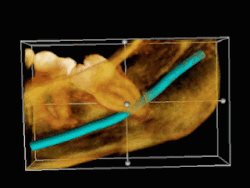Maxillary third molar
| Wisdom tooth | |
|---|---|

Wisdom teeth
|
|

|
|
| Identifiers | |
| TA | A05.1.03.008 |
|
Anatomical terminology
[]
|
|
A wisdom tooth or third molar is one of the three molars per quadrant of the human dentition. It is the most posterior of the three. Wisdom teeth generally erupt between the ages of 17 and 25. Most adults have four wisdom teeth, one in each of the four quadrants, but it is possible to have none, fewer, or more, in which case the extras are called supernumerary teeth. Wisdom teeth commonly affect other teeth as they develop, becoming impacted. They are often extracted when or even before this occurs.
Agenesis of wisdom teeth differs by population, ranging from practically zero in Aboriginal Tasmanians to nearly 100% in indigenous Mexicans (see research paper with world map showing prevalence). The difference is related to the PAX9 gene (and perhaps other genes).
Wisdom teeth are vestigial third molars that helped human ancestors to grind plant tissue. It is thought that the skulls of human ancestors had larger jaws with more teeth, which possibly helped to chew foliage to compensate for a lack of ability to efficiently digest the cellulose that makes up a plant cell wall. After the advent of agriculture over 10,000 years ago, soft human diets became the norm, including carbohydrate and high energy foods. Such diets typically result in jaws growing with less forward growth than our paleolithic ancestors and not enough room for the wisdom teeth.
Wisdom teeth (often notated clinically as M3 for third molar) have long been identified as a source of problems and continue to be the most commonly impacted teeth in the human mouth. The oldest known impacted wisdom tooth belonged to a European woman of the Magdalenian period (18,000–10,000 BCE). A lack of room to allow the teeth to erupt results in a risk of periodontal disease and dental cavities that increases with age. Less than 2% of adults age 65 years or older maintain the teeth without cavities or periodontal disease and 13% maintain unimpacted wisdom teeth without cavities or periodontal disease.
...
Wikipedia
